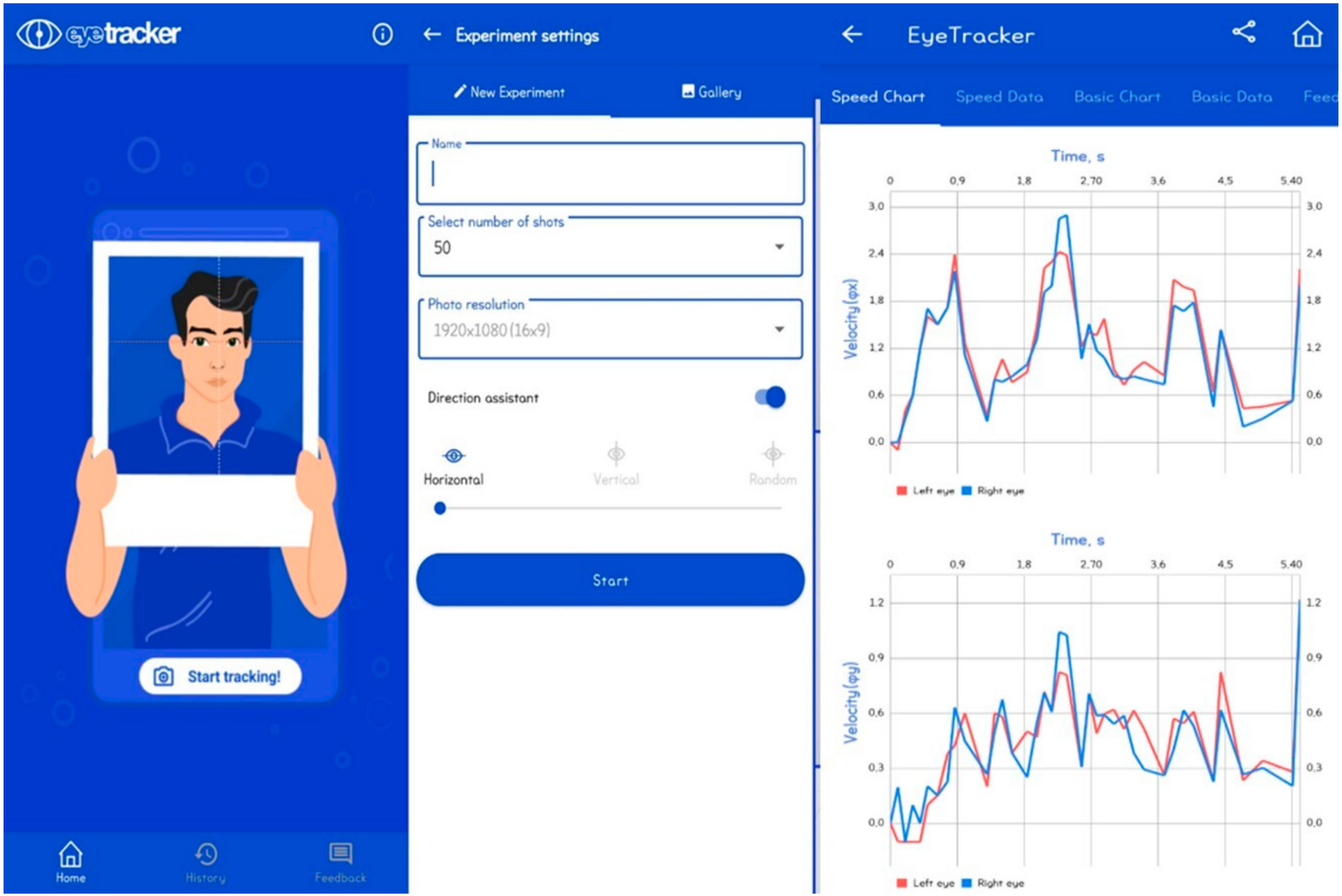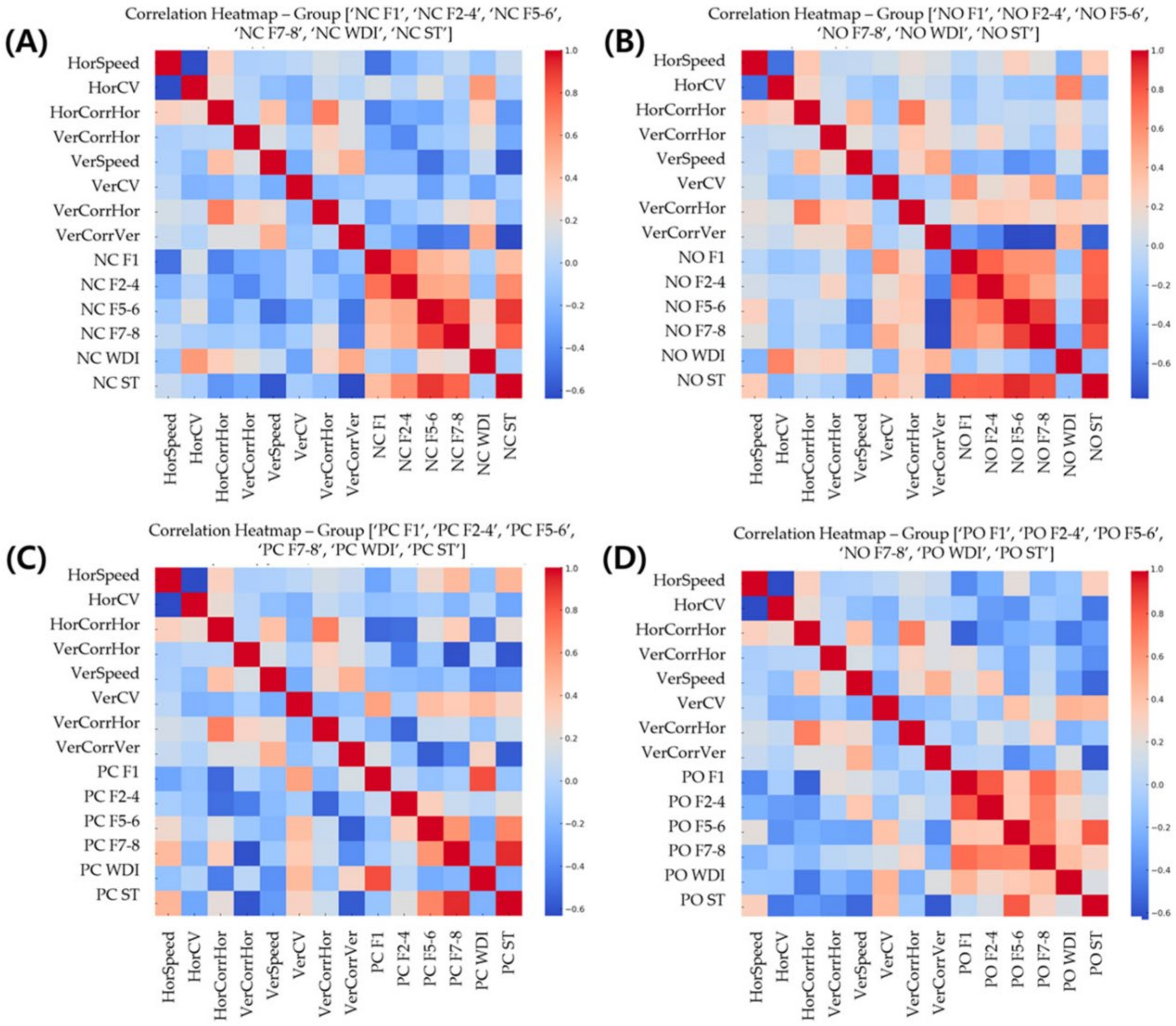Investigating Eye Movement and Postural Stability Relationships Using Mobile Eye-Tracking and Posturography: A Cross-Sectional Study
Abstract
:1. Introduction
2. Materials and Methods
2.1. Subjects
2.2. Measurements
2.2.1. Eye-Tracker
- Average speed (degrees/second): HorSpeed, VerSpeed;
- Coefficient of variation (%): HorCV, VerCV;
- Pearson correlation coefficients between left and right eye speeds:
- –
- HOR condition: HorCorr, HorVerCorr;
- –
- VER condition: VerHorCorr, VerCorr.
2.2.2. Tetrax Posturography
- Normal eyes open (NO): This condition serves as a baseline, representing typical everyday standing posture with full sensory input.
- Normal eyes closed (NC): By removing visual input, this condition assesses the reliance on vestibular and proprioceptive systems for balance maintenance, simulating situations like standing in a dark room.
- Head right (HR) and head left (HL): These conditions, with eyes closed and head turned at least 45° to the right or left, evaluate vestibular function and the ability to maintain balance with altered head orientation, mimicking everyday activities like looking sideways while standing.
- Head back (HB): With eyes closed and head tilted backward at least 30°, this condition assesses balance control during cervical extension, which is relevant for activities like looking up at high shelves or ceiling work.
- Head forward (HF): Eyes closed with head bent forward at least 30°, this condition evaluates balance during cervical flexion, simulating tasks such as reading or looking at a smartphone while standing.
- Pillow with eyes open (PO) and pillow with eyes closed (PC): These conditions, performed on a foam pillow, challenge proprioceptive input by creating an unstable surface. They assess the integration of visual (PO) or vestibular (PC) information with altered somatosensory input, simulating standing on uneven or soft surfaces like carpet or sand.
- Stability index (ST): a measure of overall postural stability, with higher values indicating greater instability. This index is clinically relevant for assessing fall risk and overall balance performance.
- Fourier indices (F1–F8): a regression analysis of postural sway intensity at different frequency bands, with each band associated with specific sensory or neurological functions:
- F1 (<0.1 Hz): visual–vestibular regulation;
- F2–F4 (0.1–0.5 Hz): vestibular disorders;
- F5–F6 (0.5–1 Hz): somatosensory disorders in the lower limbs and spine;
- F7–F8 (>1 Hz): central nervous system disorders. These indices provide detailed information about the underlying mechanisms of postural control and can help identify specific areas of dysfunction.
- Weight Distribution Index (WDI): the percentage of body weight on each force plate, with deviations from 25% per plate indicating postural asymmetry. This index is particularly relevant for assessing balance in individuals with unilateral impairments or injuries.
- Synchronization Index (SI): the similarity of postural sway patterns between pairs of force plates, with positive values indicating in-phase synchronization and negative values indicating anti-phase synchronization. This index provides insights into the coordination of postural adjustments and can be useful in identifying subtle balance disorders.
2.2.3. Experimental Procedure
2.2.4. Statistical Analysis
3. Results
3.1. Participant Characteristics
3.2. Correlations between Eye Movement Parameters and Postural Stability Indices
4. Discussion
5. Conclusions
Author Contributions
Funding
Institutional Review Board Statement
Informed Consent Statement
Data Availability Statement
Conflicts of Interest
References
- Velay, J.; Roll, R.; Lennerstrand, G.; Roll, J. Eye proprioception and visual localization in humans: Influence of ocular dominance and visual context. Vis. Res. 1994, 34, 2169–2176. [Google Scholar] [CrossRef] [PubMed]
- Land, M.; Tatler, B. Looking and Acting: Vision and Eye Movements in Natural Behaviour; Oxford University Press: Oxford, UK, 2009. [Google Scholar]
- Patla, A.E. Understanding the roles of vision in the control of human locomotion. Gait Posture 1997, 5, 54–69. [Google Scholar] [CrossRef]
- Fushiki, H.; Kobayashi, K.; Asai, M.; Watanabe, Y. Influence of visually induced self-motion on postural stability. Acta Oto-Laryngol. 2005, 125, 60–64. [Google Scholar] [CrossRef] [PubMed]
- Poggio, T.; Bizzi, E. Generalization in vision and motor control. Nature 2004, 431, 768–774. [Google Scholar] [CrossRef] [PubMed]
- Paulus, W.; Straube, A.; Brandt, T. Visual stabilization of posture: Physiological stimulus characteristics and clinical aspects. Brain 1984, 107, 1143–1163. [Google Scholar] [CrossRef] [PubMed]
- Matthis, J.S.; Muller, K.S.; Bonnen, K.L.; Hayhoe, M.M. Retinal optic flow during natural locomotion. PLoS Comput. Biol. 2022, 18, e1009575. [Google Scholar] [CrossRef] [PubMed]
- Ellmore, T.M.; McNaughton, B.L. Human path integration by optic flow. Spat. Cogn. Comput. 2004, 4, 255–272. [Google Scholar] [CrossRef]
- Horiuchi, K.; Imanaka, K.; Ishihara, M. Postural sway in the moving room scenario: New evidence for functional dissociation between self-motion perception and postural control. PLoS ONE 2021, 16, e0257212. [Google Scholar] [CrossRef]
- Thomas, N.M.; Bampouras, T.M.; Donovan, T.; Dewhurst, S. Eye movements affect postural control in young and older females. Front. Aging Neurosci. 2016, 8, 216. [Google Scholar] [CrossRef]
- Morisita, M.; Yagi, T. The stability of human eye orientation during visual fixation and imagined fixation in three dimensions. Auris Nasus Larynx 2001, 28, 301–304. [Google Scholar] [CrossRef]
- Rodrigues, S.T.; Polastri, P.F.; Carvalho, J.C.; Barela, J.A.; Moraes, R.; Barbieri, F.A. Saccadic and smooth pursuit eye movements attenuate postural sway similarly. Neurosci. Lett. 2015, 584, 292–295. [Google Scholar] [CrossRef] [PubMed]
- Matthis, J.S.; Yates, J.L.; Hayhoe, M.M. Gaze and the control of foot placement when walking in natural terrain. Curr. Biol. 2018, 28, 1224–1233.e5. [Google Scholar] [CrossRef] [PubMed]
- Boccignone, G.; Ferraro, M.; Crespi, S.; Robino, C.; de’Sperati, C. Detecting expert’s eye using a multiple-kernel relevance vector machine. J. Eye Mov. Res. 2014, 7, 1–15. [Google Scholar] [CrossRef]
- Foulsham, T.; Walker, E.; Kingstone, A. The where, what and when of gaze allocation in the lab and the natural environment. Vis. Res. 2011, 51, 1920–1931. [Google Scholar] [CrossRef]
- Causer, J.; Holmes, P.S.; Williams, A.M. Quiet eye training in a visuomotor control task. Med. Sci. Sports Exerc. 2011, 43, 1042–1049. [Google Scholar] [CrossRef] [PubMed]
- Black, F.O.; Peterka, R.J.; Shupert, C.L.; Nashner, L.M. Effects of unilateral loss of vestibular function on the vestibulo-ocular reflex and postural control. Ann. Otol. Rhinol. Laryngol. 1989, 98, 884–889. [Google Scholar] [CrossRef] [PubMed]
- Hilgendorf, J.R.; Vela, L.I.; Gobert, D.V.; Harter, R.A. Influence of vestibular--ocular reflex training on postural stability, dynamic visual acuity, and gaze stabilization in patients with chronic ankle instability. Athl. Train. Sports Health Care 2012, 4, 220–229. [Google Scholar] [CrossRef]
- Abdelmotaleb, H.; Sobhy, O.; Bassiouny, M.; Elsherif, M. Evaluation of postural stability and vestibulo-ocular reflex in adults with chronic suppurative otitis media. Eur. Arch. Oto-Rhino-Laryngol. 2023, 280, 897–905. [Google Scholar] [CrossRef] [PubMed]
- Moran, R.N.; Cochrane, G. Preliminary study on an added vestibular-ocular reflex visual conflict task for postural control. J. Clin. Transl. Res. 2020, 5, 155. [Google Scholar] [PubMed]
- Guedry, F. Spatial orientation perception and reflexive eye movements—A perspective, an overview, and some clinical implications. Brain Res. Bull. 1996, 40, 505–512. [Google Scholar] [CrossRef] [PubMed]
- Krauzlis, R.J.; Goffart, L.; Hafed, Z.M. Neuronal control of fixation and fixational eye movements. Philos. Trans. R. Soc. B Biol. Sci. 2017, 372, 20160205. [Google Scholar] [CrossRef] [PubMed]
- Wójtowicz, S.; Łakoma, A.; Ferenc, A.; Daniluk, A.; Wiaderna, K.; Hadamus, A. Effect of smooth eye tracking in different patterns on results of the modified Clinical Balance Sensory Integration Test in healthy young adults. Acta Bioeng. Biomech. 2022, 24, 57–64. [Google Scholar] [PubMed]
- Aguiar, S.A.; Polastri, P.F.; Godoi, D.; Moraes, R.; Barela, J.A.; Rodrigues, S.T. Effects of saccadic eye movements on postural control in older adults. Psychol. Neurosci. 2015, 8, 19. [Google Scholar] [CrossRef]
- Scheidt, R.A.; Ghez, C. Separate adaptive mechanisms for controlling trajectory and final position in reaching. J. Neurophysiol. 2007, 98, 3600–3613. [Google Scholar] [CrossRef] [PubMed]
- Cherici, C.; Kuang, X.; Poletti, M.; Rucci, M. Precision of sustained fixation in trained and untrained observers. J. Vis. 2012, 12, 31. [Google Scholar] [CrossRef] [PubMed]
- Ajrezo, L.; Wiener-Vacher, S.; Bucci, M.P. Saccades improve postural control: A developmental study in normal children. PLoS ONE 2013, 8, e81066. [Google Scholar] [CrossRef] [PubMed]
- Agostini, V.; Sbrollini, A.; Cavallini, C.; Busso, A.; Pignata, G.; Knaflitz, M. The role of central vision in posture: Postural sway adaptations in Stargardt patients. Gait Posture 2016, 43, 233–238. [Google Scholar] [CrossRef] [PubMed]
- Tramper, J.J.; Gielen, C. Visuomotor coordination is different for different directions in three-dimensional space. J. Neurosci. 2011, 31, 7857–7866. [Google Scholar] [CrossRef] [PubMed]
- Allum, J.; Bloem, B.; Carpenter, M.; Hulliger, M.; Hadders-Algra, M. Proprioceptive control of posture: A review of new concepts. Gait Posture 1998, 8, 214–242. [Google Scholar] [CrossRef] [PubMed]
- Frost, R.; Skidmore, J.; Santello, M.; Artemiadis, P. Sensorimotor control of gait: A novel approach for the study of the interplay of visual and proprioceptive feedback. Front. Hum. Neurosci. 2015, 9, 14. [Google Scholar] [CrossRef] [PubMed]
- Srulijes, K.; Mack, D.J.; Klenk, J.; Schwickert, L.; Ihlen, E.A.; Schwenk, M.; Lindemann, U.; Meyer, M.; Kc, S.; Hobert, M.A.; et al. Association between vestibulo-ocular reflex suppres-sion, balance, gait, and fall risk in ageing and neurodegenerative disease: Protocol of a one-year prospective follow-up study. BMC Neurol. 2015, 15, 192. [Google Scholar] [CrossRef] [PubMed]
- Stamenkovic, A.; Stapley, P.J.; Robins, R.; Hollands, M.A. Do postural constraints affect eye, head, and arm coordination? J. Neurophysiol. 2018, 120, 2066–2082. [Google Scholar] [CrossRef] [PubMed]
- Hunter, M.C.; Hoffman, M.A. Postural control: Visual and cognitive manipulations. Gait Posture 2001, 13, 41–48. [Google Scholar] [CrossRef] [PubMed]
- McCollum, G.; Shupert, C.L.; Nashner, L.M. Organizing sensory information for postural control in altered sensory environ-ments. J. Theor. Biol. 1996, 180, 257–270. [Google Scholar] [CrossRef] [PubMed]




| Variables | HorSpeed | HorCV | HorCorr | VerCorr |
|---|---|---|---|---|
| HorCV | −0.63 * | - | - | - |
| VerHorCorr | - | - | 0.69 ** | - |
| WDI (NO) | - | 0.65 * | - | - |
| WDI (NC) | - | 0.59 * | - | - |
| F2–F4 (HR) | - | - | −0.56 * | - |
| F2–F4 (HL) | - | - | −0.68 * | - |
| F1, F2–F4, F5–F6, ST (HB, HF) | - | - | * | - |
| F7–F8 ST (PC) | - | - | - | * |
| F1, F2–F4, F5–F6, F7–F8, ST (NO, PC, HL, HB, HF) | - | - | - | ** |
Disclaimer/Publisher’s Note: The statements, opinions and data contained in all publications are solely those of the individual author(s) and contributor(s) and not of MDPI and/or the editor(s). MDPI and/or the editor(s) disclaim responsibility for any injury to people or property resulting from any ideas, methods, instructions or products referred to in the content. |
© 2024 by the authors. Licensee MDPI, Basel, Switzerland. This article is an open access article distributed under the terms and conditions of the Creative Commons Attribution (CC BY) license (https://creativecommons.org/licenses/by/4.0/).
Share and Cite
Park, S.-Y.; Kang, T.-W.; Koo, D.-K. Investigating Eye Movement and Postural Stability Relationships Using Mobile Eye-Tracking and Posturography: A Cross-Sectional Study. Bioengineering 2024, 11, 742. https://doi.org/10.3390/bioengineering11080742
Park S-Y, Kang T-W, Koo D-K. Investigating Eye Movement and Postural Stability Relationships Using Mobile Eye-Tracking and Posturography: A Cross-Sectional Study. Bioengineering. 2024; 11(8):742. https://doi.org/10.3390/bioengineering11080742
Chicago/Turabian StylePark, Seo-Yoon, Tae-Woo Kang, and Dong-Kyun Koo. 2024. "Investigating Eye Movement and Postural Stability Relationships Using Mobile Eye-Tracking and Posturography: A Cross-Sectional Study" Bioengineering 11, no. 8: 742. https://doi.org/10.3390/bioengineering11080742






